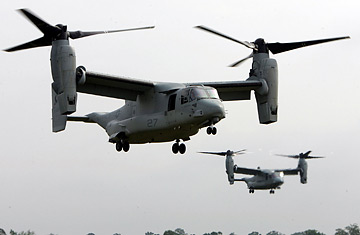
Two V-22 Ospreys.
After investing $20 billion over 25 years and losing 30 lives in the development of the controversial V-22 tilt-rotor aircraft, known as the Osprey, the U.S. military might like to think that its long-awaited combat debut would go relatively smoothly. But even as 10 Marine V-22s have just arrived in Iraq, the Air Force — which is buying V-22s for special operations missions — has decided the gun on the Marines' version isn't good enough for an aircraft expressly designed to ferry troops into hot landing zones.
The Marines now flying the $120 million aircraft have insisted that the small gun slung from the aircraft's opened rear ramp is adequate for war. That's a claim disputed by retired Marine general James Jones, who ordered a beefed-up, forward-firing gun for the V-22 when he was serving as the Corps' top officer from 1999 to 2003. The requirement evaporated after Jones stepped down as commandant, but the Air Force, which is buying 50 V-22s for the Special Ops command, seems to agree with Jones.
"It is critical that the CV-22 possess a self-defense capability that will provide maximum protection from threats in the vicinity of the landing zone," the Special Op Command says in a recent message to contractors seeking an improved gun. Its list of requirements shows that the gun now on the V-22s in Iraq falls far short of what it wants, including "maximum coverage of all quadrants" — in other words, the ability to fire in the direction that the V-22 is going, not merely where it has been, as is the case with the current gun. The special-ops V-22 is slated to enter service in 2009.
This dispute is just the latest chapter in a troubled program begun in 1981 to provide a troop transport for all four military services; the Army dropped out two years later for cost reasons, and then-Defense Secretary Dick Cheney, also citing cost, failed to kill it over objections from Congress — and the Marines. The V-22, built by Bell Helicopter and the Boeing Co., was deemed ideal for carrying troops because it can take off and land like a helicopter, then tilt its engines and rotors forward to fly like a turboprop airplane. After three fatal crashes, numerous delays and compromises that some inside the military believe endanger those on board, the 10 V-22s are finally based at al Asad air base in western Iraq (the Marines have clamped down on all information about their operations, but expect a formal Iraqi unveiling of the V-22s soon).
At least one contractor agrees with the Air Force that the interim gun aboard the V-22 is wanting. BAE Systems has been investing in the development of a remotely aimed gun that could be slung from the V-22's belly and installed starting in about a year, BAE officials say. The gun, which could range in size from 7.62 mm (the size of the current gun) to .50-cal. (the size Jones wanted) would protrude from the V-22's belly, just forward of the swiveling gun. A V-22 crew member located in the passenger compartment would fire the gun, based on the video images displayed, with a hand-held controller. A Pentagon official says this design, while perhaps adequate for special-ops V-22s, wouldn't replace the need for a final weapon for the Marine V-22 that would be integrated into the aircraft's internal electronic and computer systems. The Pentagon is seeking $82 million to develop a permanent gun, on top of the $45 million it already spent trying to meet Jones' requirement for one.
V-22 pilots like Marine Lieutenant Colonel Anthony "Buddy" Bianca know their aircraft is heading off to war with inadequate firepower. "It says right there in the ORD" — the Operational Requirements Document specifying what the aircraft must be able to do — that "the aircraft is supposed to have 360 degrees field of fire with a defensive weapon," says Bianca, who has spent 1,300 hours flying the V-22 over the past eight years. "I don't care if it's a turret, you stick it out of a window or you patch it on with bubblegum, but we've got to find a way to do that." Bianca, 40, told TIME that the current rear gun is "not the answer," and that Marines are planning on installing a better gun eventually. He pauses when asked if he thinks the V-22 should be sent to Iraq with the small, ramp-mounted gun as its only weapon. "That question," he says, "is not mine to say."
But as has always been the case in war, the more junior the officer, the less concerned he is about the weapon he is bringing to the fight. The gun doesn't faze Captain Justin "Moon" McKinney from Albany, Georgia, who has spent nearly 200 hours flying the V-22 over the past year. McKinney, 30, and his fellow "Thunder Chickens" of Marine Medium Tiltrotor Squadron 263 from Jacksonville, N.C., are now in Iraq. "I think the weapon," he said as he readied for the deployment, "is very sufficient."
Bianca recalls why Jones' original scheme for a bigger gun was scrapped. "It was primarily cost, to be honest with you," he said. "I was in the room when [the contractors] were basically told that 'this was our price-tag limits to develop this weapon' and they came back with a price tag and were told, `Well guys, you just designed yourself out of a weapons system.'" The gun's ultimate cost — $1.5 million a copy — ended up being too expensive in the Pentagon's eyes. That price — barely more than 1% of the V-22's current cost — ultimately doomed it, and sent the aircraft to Iraq sporting a weapon some Marines deride as a "peashooter."
